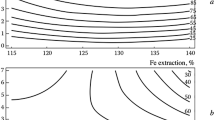Laboratory studies are performed for leaching oxidized nickel ore with hydrochloric acid in relation to temperature, leaching duration, and leaching acid consumption. It is revealed that the amount of hydrochloric acid dispensed has the greatest effect on metal extraction into solution. The maximum nickel extraction into solution is 88.2%.




Similar content being viewed by others
References
N. I. Gran’, B. P. Onishchin, and E. I. Maizel, Electric Melting of Oxidized Nickel Ores, Metallurgiya, Moscow (1971).
I. D. Reznik, T. A. Kharlakova, and O. V. Konyaev, “Conversion of Ural nickel plants to melting ferronickel in shaft furnaces,” Tsvet. Met., No. 6, 17–19 (1987).
I. D. Reznik, G. P. Ermakov, and Y. M. Shneerson, Nickel, Mashinostroenie, Moscow (2000).
Author information
Authors and Affiliations
Corresponding author
Additional information
Translated from Metallurg, No. 1, pp. 91–93, January, 2015.
Rights and permissions
About this article
Cite this article
Kolmachikhina, O.B., Kolmachikhin, V.N. & Naboichenko, S.S. Study of Serov Deposit Oxidized Nickel Ore Hydrochloric Acid Leaching. Metallurgist 59, 87–89 (2015). https://doi.org/10.1007/s11015-015-0065-x
Received:
Published:
Issue Date:
DOI: https://doi.org/10.1007/s11015-015-0065-x




